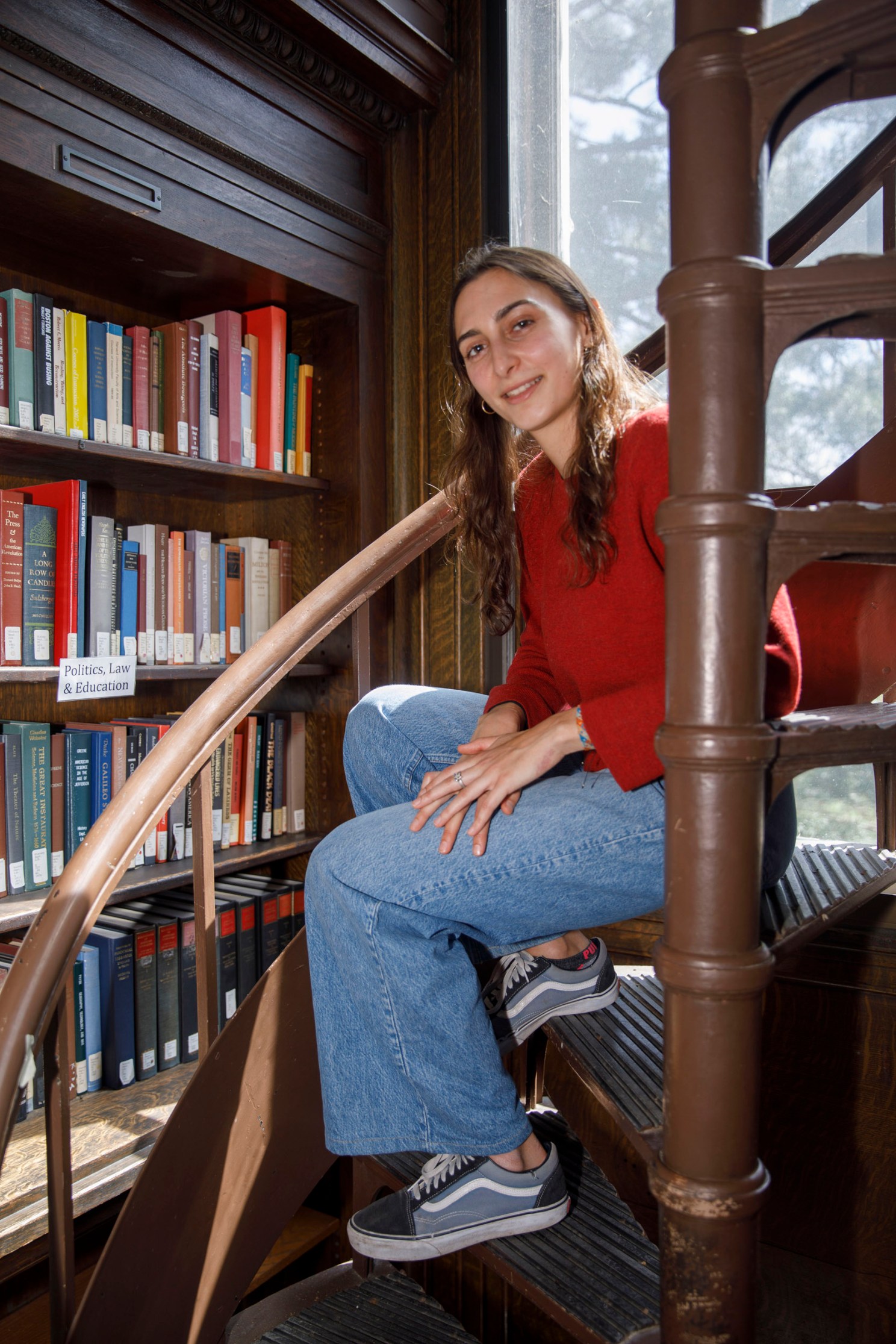
Julia Tellides.
Kris Snibbe/Harvard Staff Photographer
Tracing largely forgotten history of major community
Julia Tellides explored shifts, upheavals of Thessaloniki between two wars
Part of the Commencement 2024 series
A collection of stories covering Harvard University’s 373rd Commencement.
Julia Tellides discovered the rich Jewish heritage of Thessaloniki two years ago on a Harvard Summer School Study Abroad program.
“It was the first time I heard about there being a large Jewish community anywhere in Greece,” said the graduating senior, a joint history and classics concentrator. “I thought, why have I never heard about this before? If anyone should know about this history, it’s me.”
Tellides, who grew up in New Haven, Connecticut, with a Greek father and Jewish mother, went on to devote her senior thesis to the city’s politically active Jewish residents during a period of upheaval in the early 20th century. Once home to the largest Sephardic Jewish population in Europe, Thessaloniki (traditionally known as Salonica or Salonika) proved a gold mine of Jewish culture and resistance, with Tellides surfacing new insights on the community’s struggle for survival.
“For an undergraduate to have gone into such depth, and with such originality, is remarkable,” said Tellides’ thesis adviser Derek Penslar, the William Lee Frost Professor of Jewish History and director of Harvard’s Center for Jewish Studies.
Greece’s second-largest city, situated 300 miles north of Athens on the Aegean Sea, once served as an economic and cultural crossroads. “It was one of the most important ports in the Ottoman Empire,” Tellides explained. It was also a melting pot where Jews, Muslims, and Christians coexisted in relative peace.
That changed when the Greek government took control in the early 20th century, with Thessaloniki changing from “a multicultural, multireligious empire to a Christian nation-state,” said Tellides, whose second thesis adviser was Paul J. Kosmin, the Philip J. King Professor of Ancient History.
According to a 1913 census, the Jewish population in Thessaloniki numbered around 90,000. Tellides’ scholarship focused on the community’s activism in the years between World Wars I and II, with Jewish residents organizing in opposition to rising antisemitism and discriminatory public policy. One example is a 1924 mandate for all businesses to remain closed on Sundays.
“Other historians have acknowledged the significance of the Sunday closing law — if Jews observed the Sabbath they effectively lost a day of work, which made it very hard to make a living,” Penslar noted. “Julia’s original contribution was depicting how the Jewish community reacted to the crisis, how they interceded with the Greek government, and even more interestingly how they interceded with international organizations in the spirit of the Minority Rights Treaties created after World War I.”
Tellides, a history lover from childhood, also examined a moment in the 1930s when the Greek government sought to take over the city’s vast Jewish cemetery, with more than 350,000 graves dating as far back as the Roman era. “They wanted to build a university campus on top of it,” she said.
With support from Harvard’s Minda de Gunzburg Center for European Studies, Center for Jewish Studies, and Department of the Classics, the Leverett House resident traveled to Thessaloniki last summer to conduct archival research and explore the city. But Tellides, who bolstered her Greek skills with coursework at Harvard, quickly found herself unable to decipher materials written in Ladino, a Romance language developed by Sephardic Jews expelled from Spain in the late 15th century.
“Many of these spaces
commemorate the community’s death rather than its life.”
“What I read instead was their correspondence with international Jewish organizations,” shared Tellides, who plans to teach English to kindergarteners in Athens following graduation. “They were desperately trying to overturn these laws through diplomatic channels, political pressure — anything they could possibly do.”
As Tellides walked the streets of Thessaloniki, she found little that celebrated the city’s Jewish heritage. All that exists are a couple of Holocaust memorials, two surviving synagogues, and a small but impressive Jewish museum.
“Many of these spaces commemorate the community’s death rather than its life,” she writes in her thesis before calling for more memorials to the lasting influence of Jewish residents.
One thing the city has in abundance are vestiges of the ancient Jewish cemetery, which was in fact dismantled during the Holocaust. “They used the tombstones to rebuild after World War II,” Tellides said. “They’re built into landscaping walls and parks. One of the biggest churches has Hebrew inscriptions in its floor.”
That harrowing chapter wasn’t a focus for Tellides, but it was impossible to set aside entirely. Thousands of Jews had already left Thessaloniki by the 1940s. During Nazi occupation, about 96 percent of the remaining population was deported and killed in concentration camps.
“So much is gone. Not only in terms of the amount of people killed, but all their synagogues, communal centers, and neighborhoods — everything was confiscated or actively destroyed during World War II.”
“So much is gone,” Tellides said. “Not only in terms of the amount of people killed, but all their synagogues, communal centers, and neighborhoods — everything was confiscated or actively destroyed during World War II.”
For Tellides, the scale of loss made it all the more important to focus on the interwar period. “It’s really inspiring, but also difficult to understand how hard they were working to save their community,” she said.
“The thesis is a case study of the failure of the Minority Rights system of the interwar era,” Penslar observed. “Julia catalogs and analyzes Jewish activism and agency in Thessaloniki in ways that go well beyond existing scholarly literature on the subject.”




